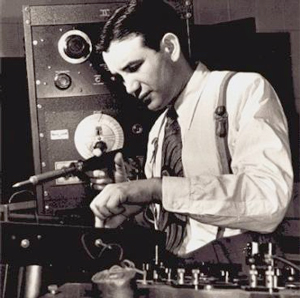by Daniel Hathaway

Cleveland’s classy and enterprising new music ensemble, No Exit, led by Timothy Beyer and comprised of violinist Cara Tweed, violist James Rhodes, flutist Sean Gabriel, percussionist Luke Rinderknecht, cellist Nicholas Diodore, pianists Nicholas Underhill and James Praznik and assistant artistic director and composer Eric M.C. Gonzalez, invited guest performers Russ Gershon, saxophones and flute, percussionists Dinesh Joseph and trumpeter Scott McKee to celebrate Scott’s legacy in three concerts last weekend in Cleveland and Buffalo. I caught the third show on Monday evening in Drinko Recital Hall at Cleveland State University.
In just over ninety minutes, No Exit introduced Monday evening’s small but enthusiastic audience to a baker’s dozen of Scott’s creations in arrangements by Geoffrey Burleson, Russ Gershon, Christopher Auerbach-Brown, Eric Gonzalez and Greg D’Alessio, plus two new tribute pieces by Timothy Beyer and James Praznik.
Scott’s delicious titles — Powerhouse Passacaglia, Snake Woman, The Man at the Typewriter, Celebration on the Planet Mars, War Dance for Wooden Indians — headline some infectious pieces of music that thrive somewhere on the permeable borders between concert music, jazz and blues. But both Scott’s musical scores and his electronic creations share an affection for an underlying beat and catchy rhythms — no primordial ooze here.
Some of those sound clips that were interspersed between musical selections were beguilingly goofy — Bob & Ray-like sendups of radio commercials, a virtual (and eventually disastrous) tour of the inside of one’s head — playful creations from the inventive mind of an individual who remains “uniquely unique,” as Beyer wrote in the program notes.
The newly composed works were appropriately inventive as well. Beyer’s own tribute, Egyptian Barn Dance Meditation, drew on a Webern-like pointillism, while Praznik’s was in a head-bobbing, “heavy ivory” style with the composer as manic pianist.
One amusing piece, The Man at the Typewriter, proved to be more authentic than Scott’s original, which used wood block and triangle to simulate the sound of a manual typewriter. As arranged by Auerbach-Brown, the short piece used The Real Thing.
Monday night’s excellent performances — which moved right along from one short piece to the next — were well-documented in a chic program book that reflected the care and level of detail Timothy Beyer lavishes on his twice-yearly productions. More people should seek out these entertaining and enlightening performances.
Published on ClevelandClassical.com November 26, 2013
Click here for a printable version of this article.



